THE ARCHDUKE FERDINAND MAXIMILIAN (1832-1867)
The second son of Archduke Franz Karl and the Archduchess Sophie of Austria was born in the palace of Schönbrunn in Vienna on the 6th July, 1832. Ferdinand Max grew up a lively boy full of curiosity, with a romantic and imaginative nature. Although his mother's favourite, he always maintained close and affectionate relations with his elder brother, the future Emperor Francis Joseph. His choice of careers led the archduke into the imperial navy. Ferdinand Max loved the sea and the Adriatic coast, and he decided to build his romantic castle of Miramar just outside the port of Trieste.
THE GOVERNOR-GENERAL
In 1857 Francis Joseph appointed his brother to the post of governor-general
in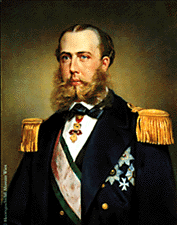 the Austrian held provinces of
northern Italy, the Kingdom of Lombardy-Venetia. The Archduke Ferdinand
Maximilian took up his residence at Monza outside Milan with his new bride, the
Princess Charlotte of Belgium. The Austrians were far from popular in northern
Italy, but despite resistance from the military authorities, the vice-regal
couple began slowly to win over many Italians. Ferdinand Maximilian's liberalism
aroused less enthusiasm in Vienna, however, where he was increasingly seen as
being in opposition to his imperial brother's government.
the Austrian held provinces of
northern Italy, the Kingdom of Lombardy-Venetia. The Archduke Ferdinand
Maximilian took up his residence at Monza outside Milan with his new bride, the
Princess Charlotte of Belgium. The Austrians were far from popular in northern
Italy, but despite resistance from the military authorities, the vice-regal
couple began slowly to win over many Italians. Ferdinand Maximilian's liberalism
aroused less enthusiasm in Vienna, however, where he was increasingly seen as
being in opposition to his imperial brother's government.
With the approach of war in 1859 against France and the north Italian kingdom of Piedmont-Sardinia, Francis Joseph relieved his brother of his office and gave full power to the military. Both the archduke and his wife resented this dismissal.
THE IMPERIO MEXICANO
Ferdinand Max returned to his castle of Miramar, but events across the Atlantic would soon put an end to his political inactivity. An army of intervention consisting of Spanish, English and French troops had landed in Mexico to enforce payment of the huge foreign debts of the Mexican republic. The Spanish and English soon withdrew, but the French troops of Napoleon III remained to establish a conservative, pro-French regime. To achieve this they decided to re-establish a monarchy, and in October,1863, a Mexican delegation offered the crown to Ferdinand Max as a prince of the first European dynasty to have ruled Mexico centuries before.
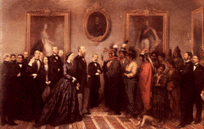 On the advice of Francis Joseph
the support of Napoleon III was secured in writing. The U.S. government
protested at what was seen as an infringement of the Monroe Doctrine, but the
civil war between the states prevented their taking action.
On the advice of Francis Joseph
the support of Napoleon III was secured in writing. The U.S. government
protested at what was seen as an infringement of the Monroe Doctrine, but the
civil war between the states prevented their taking action.
After an apparently favourable plebiscite in Mexico, the Archduke Ferdinand Maximilian accepted the imperial crown at Miramar on the 10th April,1864. Four days later he and his wife went on board the ship S.M.S. "Novara" to set sail for their new homeland as the Emperor and the Empress of Mexico.
THE EMPERADOR MAXIMILIANO
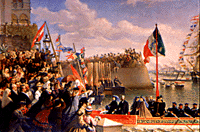 On their arrival at Vera Cruz on
the coast of Mexico, they were horrified to discover that their new realm was
still embroiled in civil war. The French had achieved the upper hand, but the
liberals and the republicans were still offering bitter resistance under their
president, Benito Juárez. If Maximilian was disillusioned and disappointed, his
supporters were soon equally disappointed in their new emperor. Far from
governing in the interests of the French and the conservatives, Maximilian saw
himself as a figure of national integration. The welfare of all his subjects was
his first concern. He cherished the vain hope that his liberalism would enable a
reconciliation of the republican opposition. He did not understand that they did
not want an emperor, no matter how liberal! To Juárez and his followers
Maximilian would always remain the "Austríaco".
On their arrival at Vera Cruz on
the coast of Mexico, they were horrified to discover that their new realm was
still embroiled in civil war. The French had achieved the upper hand, but the
liberals and the republicans were still offering bitter resistance under their
president, Benito Juárez. If Maximilian was disillusioned and disappointed, his
supporters were soon equally disappointed in their new emperor. Far from
governing in the interests of the French and the conservatives, Maximilian saw
himself as a figure of national integration. The welfare of all his subjects was
his first concern. He cherished the vain hope that his liberalism would enable a
reconciliation of the republican opposition. He did not understand that they did
not want an emperor, no matter how liberal! To Juárez and his followers
Maximilian would always remain the "Austríaco".
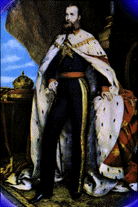 The end of the American Civil
War gave new hope to the Mexican republicans. The Emperor Napoleon III came
under massive pressure to withdraw his French troops from Mexico. In mid-1866
Charlotte returned to Europe to try to shame Napoleon into honouring his written
promises to Maximilian, but Paris was deaf to all her pleas and threats. The
desperation of failure plunged the young empress into the mania of a persecution
complex. It was a madness that would persist until her death in 1927.
The end of the American Civil
War gave new hope to the Mexican republicans. The Emperor Napoleon III came
under massive pressure to withdraw his French troops from Mexico. In mid-1866
Charlotte returned to Europe to try to shame Napoleon into honouring his written
promises to Maximilian, but Paris was deaf to all her pleas and threats. The
desperation of failure plunged the young empress into the mania of a persecution
complex. It was a madness that would persist until her death in 1927.
THE HILL OF THE BELLS
On the 13th February, 1867, after the rejection by Juárez of a renewed offer of peace, the Emperor Maximilian left Mexico City with his "national" army for the town of Querétaro some 100 miles to the north. Here the Mexican Empire would make its stand. Unfortunately, the jealousies and rivalries between his generals greatly reduced the effectiveness of Maximilian's forces, and he and his troops were soon besieged in Querétaro by the advancing republican armies. On the 15th May Colonel López betrayed the town into the hands of the republicans. Maximilian and his loyal generals Miramón and Mejía were arraigned before a military tribunal and condemned to death.
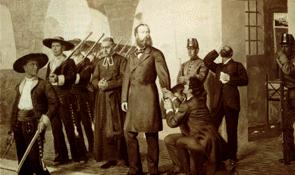 At dawn on the 19th June, 1867,
the three men were taken out to the Cerro de las Campanas (the Hill of the
Bells), where they were executed by a firing squad.
At dawn on the 19th June, 1867,
the three men were taken out to the Cerro de las Campanas (the Hill of the
Bells), where they were executed by a firing squad.
His last words were:
"I forgive everyone, and I ask everyone to forgive me. May my blood which is
about to be shed, be for the good of the country. Viva Mexico, viva la
independencia!"
After difficult negotiations with an unwilling Juárez, who had had to stomach the criticism of even friendly Washington, Maximilian's body was returned to Austria. The same ship, S.M.S. "Novara", which had brought him to Mexico, now carried his embalmed body back to Trieste and to its final resting place in the imperial crypt in Vienna.
The tragedy of Maximilian was that he assumed the crown of Mexico in good
faith and full of the best intentions. He was upright and honest, and genuinely
wanted to lead Mexico into an age of peace and prosperity. It was his fate to be
deceived by the political realities, and then to be prevented by his essentially
noble character from cutting his losses to save his own life.